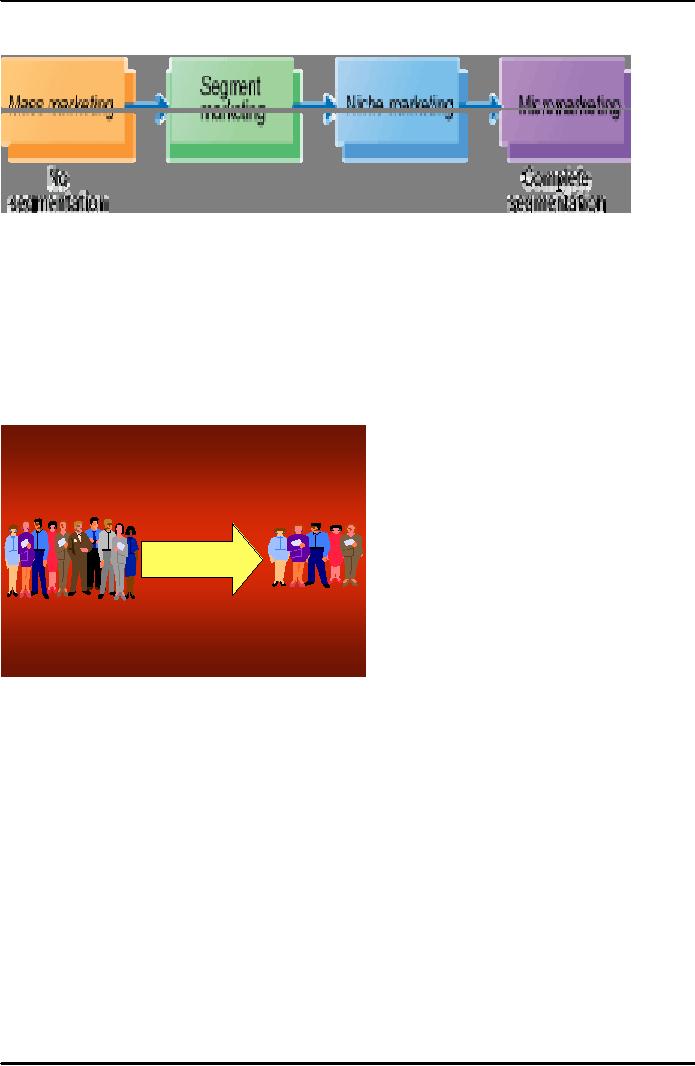 |

Principles
of Marketing MGT301
VU
Lesson
17
Lesson
overview and learning objectives:
The
Lesson emphasizes the key
steps in: market segmentation; market targeting,
and market
positioning.
Market segmentation provides a method to divide or
segment the market into
narrow
segments
(using a variety of different meaningful
variables. Today we will be
discussing the major
variables
that can be used to segment
the consumer markets.
MARKET
SEGMENTATION
A.
Market Segmentation:
Markets
consist of buyers, and buyers differ in
one or more ways. They may
differ in their wants,
resources,
locations, buying attitudes, and buying
practices. Through market
segmentation,
companies
divide large, heterogeneous markets
into smaller segments that
can be reached more
efficiently
and effectively with
products and services that
match their unique needs.
Companies
today
recognize that they cannot
appeal to all buyers in the
marketplace, or at least not to
all buyers
in
the same way. Buyers
are too numerous, too
widely scattered, and too
varied in their needs
and
buying
practices. Moreover, the
companies themselves vary
widely in their abilities to
serve
different
segments of the market. Rather than
trying to compete in an entire market,
sometimes
against
superior competitors, each company
must identify the parts of
the market that it can
serve
best
and most profitably.
Thus,
most companies are more
selective about the customers
with whom they wish to
connect.
Most
have moved away from
mass marketing and toward market
segmentation and targeting--
identifying
market segments, selecting one or more of
them, and developing products
and
marketing
programs tailored to each. Instead of
scattering their marketing
efforts firms are
focusing
on the buyers who have
greater interest in the values
they create best.
B.
Steps in Target
Marketing:
Figure
shows the three major
steps in target marketing. The
first is market
segmentation--
dividing
a market into smaller groups of buyers with
distinct needs, characteristics, or
behaviors
who
might require separate products or
marketing mixes. The company identifies
different ways to
segment
the market and develops
profiles of the resulting market
segments. The second step
is
market
targeting--evaluating
each market segment's attractiveness
and selecting one or more
of
the
market segments to enter. The
third step is market
positioning--setting
the competitive
positioning
for the product and
creating a detailed marketing mix. We
discuss each of these
steps
in
turn.
C.
Levels of Market Segmentation
Because
buyers have unique needs and
wants, each buyer is potentially a
separate market. Ideally,
then,
a seller might design a
separate
Market
Segmentation
marketing
program for each
buyer.
However,
although some companies
1.
seentiey tinsets
eomarket
Id
f
ba
f r
gm
n g h
attempt
to serve buyers individually, many
2.
Develop segment profiles
others
face larger numbers of smaller
buyers
Market
Targeting
and
do not find complete segmentation
3.
Develop measure of
worthwhile.
Instead, they look for
broader
segment
attractiveness
classes
of buyers who differ in their
product
4.
Select target
segments
needs
or buying responses. Thus,
market
segmentation
can be carried out at
several
Market
positioning
different
levels. Figure shows
that
5.
Develop positioning
for
target
segments
companies
can practice no segmentation
6.
Develop a marketing
(mass
marketing), complete segmentation
mix
for each segment
82

Principles
of Marketing MGT301
VU
(micromarketing),
or something in between (segment
marketing or niche marketing).
Levels
of marketing segmentation
a)
Mass Marketing
Companies
have not always practiced
target marketing. In fact, for
most of the 1900s,
major
consumer
products companies held fast to
mass marketing--mass producing,
mass distributing,
and
mass promoting about the
same product in about the
same way to all consumers. Henry
Ford
epitomized
this marketing strategy when
he offered the Model T Ford
to all buyers; they
could
have
the car" in any color as
long as it is black." Similarly,
Coca-Cola at one time produced
only
one
drink for the whole market,
hoping it would appeal to
everyone.
The
traditional argument for
mass marketing is that it creates
the largest potential market,
which
leads
to the lowest costs, which
in turn can
translate
into either lower prices or
higher
margins.
However, many factors now
make
mass
marketing more difficult.
The
proliferation
of distribution channels and
advertising
media has also made it
difficult
to
practice "one-size-fits-all"
marketing.
Segm
entation
b)
Segment Marketing
A
company that practices
segment
marketing
isolates broad segments that
make
up
a market and adapts its offers to
more
closely
match the needs of one or
more
segments.
Thus, Marriott markets to a
variety of segments--business travelers, families,
and
others--with
packages adapted to their
varying needs. Segment marketing
offers several benefits
over
mass marketing. The company
can market more efficiently, targeting
its products or services,
channels,
and communications programs
toward only consumers that
it can serve best and
most
profitably.
The company can also market
more effectively by fine-tuning its
products, prices, and
programs
to the needs of carefully defined
segments. The company may
face fewer competitors
if
fewer
competitors are focusing on
this market segment.
c)
Niche Marketing
Market
segments are normally large,
identifiable groups within a market--for
example, luxury car
buyers,
performance car buyers, utility car
buyers, and economy car buyers.
Niche marketing
focuses
on subgroups within these segments. A
niche is a more narrowly defined group,
usually
identified
by dividing a segment into
sub segments or by defining a
group with a distinctive set
of
traits
who may seek a special
combination of benefits. Whereas segments
are fairly large
and
normally
attract several competitors,
niches are smaller and
normally attract only one or a
few
competitors.
Niche marketers presumably understand
their niches' needs so well
that their
customers
willingly pay a price
premium.
83

Principles
of Marketing MGT301
VU
d)
Micro marketing
Segment
and niche marketers tailor
their offers and marketing
programs to meet the needs
of
various
market segments. At the same
time, however, they do not
customize their offers to
each
individual
customer. Thus, segment marketing
and niche marketing fall
between the extremes
of
mass
marketing and micro marketing. Micro
marketing is the practice of tailoring
products and
marketing
programs to suit the tastes
of specific individuals and locations.
Micro marketing
includes
local marketing (Local marketing involves
tailoring brands and
promotions to the
needs
and
wants of local customer groups--cities, neighborhoods,
and even specific stores.
Citibank
provides
different mixes of banking services in
its branches depending on
neighborhood
demographics)
and individual marketing (tailoring
products and marketing programs to
the needs
and
preferences of individual
customers).
D.
Segmenting
Consumer Markets
There
is no single way to segment a market. A marketer
has to try different segmentation
variables,
alone
and in combination, to find
the best way to view the
market structure. The major
variables
that
might be used in segmenting
are major geographic,
demographic, psychographics,
and
behavioral
variables.
a)
Geographic Segmentation
Geographic
segmentation calls for dividing
the market into different
geographical units such as
nations,
regions, states, counties, cities, or
neighborhoods. A company may decide to
operate in
one
or a few geographical areas, or to
operate in all areas but
pay attention to
geographical
differences
in needs and wants. It is common to
localize products, advertising, promotions,
and
sales
efforts to fit the needs of
geographical areas (regions,
cities, and even
neighborhoods).
b)
Demographic Segmentation
Demographic
segmentation divides the market into
groups based on variables such as age,
gender,
family
size, family life cycle,
income, occupation, education, religion,
race, and
nationality.
Demographic
factors are the most
popular bases for segmenting
customer groups. One reason
is
that
consumer needs, wants, and usage
rates often vary closely
with demographic variables.
Another
is that demographic variables
are easier to measure than
most other types of
variables.
Even
when market segments are
first defined using other bases, such as
benefits sought or
behavior,
their demographic characteristics
must be known in order to
assess the size of the
target
market
and to reach it efficiently. Demographic
variables are easier to
measure than most
other
types
of variables.
I.
Age and Life-Cycle
Stage
Age
and life cycle segmentation
consists of offering different
products or using different
marketing
approaches
for different age and
life-cycle groups. Marketers must guard
against stereotypes
when
using
this form of segmentation. While certain
age and life cycle groups do
behave similarly, age
is
often
a poor predictor of a person's
life cycle, health, work or
family status, needs, and
buying
power.
Consumer needs and wants change
with age. Some companies
use age and life
cycle
segmentation,
offering different products or using
different marketing approaches for
different age
and
life-cycle groups.
II.
Gender segmentation
calls
for dividing a market into
different groups based on sex.
This segmentation form has
long
been
used for clothing,
cosmetics, toiletries, and magazines.
New opportunities in this
area are
emerging
such as automobiles, deodorants, and financial
services. There is an increased
emphasis
on
marketing and advertising to women.
Specialized Web sites are
becoming very popular with
this
group.
84

Principles
of Marketing MGT301
VU
III.
Income segmentation
It
consists of dividing a market into
different income groups. Marketers for automobiles,
boats,
clothing,
cosmetics, financial services,
and travel have long
used this form of segmentation.
Using
this
form, marketers must remember
that they do not always
have to target the affluent.
Other
income
groups are also viable and
profitable market segments.
c)
Psychographics segmentation
It
calls
for
dividing
a
market
into
different
groups
based
on social class, lifestyle, or
personality characteristics. People in
the same demographic
class
can
exhibit very different
psychographics characteristics. As
previously seen in,
lifestyle
also
affects
people's interest in various goods, and
the goods they buy
express those lifestyles. This
method
of segmentation is gaining in popularity.
Personality
variables
can also be used to
segment
markets. Marketers will give
their products personalities
that correspond to consumer
personalities.
d)
Behavioral segmentation
It
involves dividing a market into groups
based on consumer knowledge, attitudes, uses,
or
responses
to a product. Many marketers
believe that behavior
variables are the best
starting point
for
building market segments. Occasion segmentation
consists of dividing the market
into groups
according
to occasions when buyers get
the idea to buy, actually
make their purchase, or use
the
purchased
item. Benefit segmentation involves
dividing the market into groups
according to the
different
benefits the consumers seek from
the product. Companies can
use benefit segmentation
to
clarify the benefit segment
to which they are appealing,
its characteristics, and the
major
competing
brands. They can also
search for new benefits and
establish brands that
deliver them.
User
status can
also be used to divide the market.
Segments of nonusers, ex-users,
potential
users,
first-time users, and regular
users of a product are
potential ways to segment.
Usage
rates
are
another way that marketers
segment markets. These
categories might be light,
medium, and
heavy
user groups. Loyalty
status can
also be used to segment
markets. Consumers can be
loyal
to
brands, stores, and
companies. Consumers can be
completely loyal, somewhat loyal, or
not loyal
at
all. An amazing amount of
information can be uncovered by
studying loyalty patterns.
Today
there is a trend toward targeting
multiple segments. Very
often, companies begin
their
marketing
with one targeted segment,
and then expand into
other segments. This often
boosts a
company's
competitive advantage and knowledge of
the customer base. One
of the most
promising
developments in multivariable segmentation is "geodemographic"
segmentation based
upon
both geographic and
demographic variables.
KEY
TERMS
Market
segmentation
dividing
a market into smaller groups
Market
targeting
evaluating
each market segment's attractiveness
and selecting one or
more
of the market segments to
enter
Market
positioning
setting
the competitive positioning
for the product
Geographic
segmentation dividing
the market into different
geographical units
Demographic
segmentation divides
the market into groups based on
variables such as age,
gender,
family size, family life
cycle, income, occupation,
education,
religion,
race, and
nationality.
Behavioral
segmentation involves
dividing a market into groups based on
consumer
knowledge,
attitudes, uses, or responses to a
product.
85
Table of Contents:
- PRINCIPLES OF MARKETING:Introduction of Marketing, How is Marketing Done?
- ROAD MAP:UNDERSTANDING MARKETING AND MARKETING PROCESS
- MARKETING FUNCTIONS:CUSTOMER RELATIONSHIP MANAGEMENT
- MARKETING IN HISTORICAL PERSPECTIVE AND EVOLUTION OF MARKETING:End of the Mass Market
- MARKETING CHALLENGES IN THE 21st CENTURY:Connections with Customers
- STRATEGIC PLANNING AND MARKETING PROCESS:Setting Company Objectives and Goals
- PORTFOLIO ANALYSIS:MARKETING PROCESS,Marketing Strategy Planning Process
- MARKETING PROCESS:Analyzing marketing opportunities, Contents of Marketing Plan
- MARKETING ENVIRONMENT:The Company’s Microenvironment, Customers
- MARKETING MACRO ENVIRONMENT:Demographic Environment, Cultural Environment
- ANALYZING MARKETING OPPORTUNITIES AND DEVELOPING STRATEGIES:MIS, Marketing Research
- THE MARKETING RESEARCH PROCESS:Developing the Research Plan, Research Approaches
- THE MARKETING RESEARCH PROCESS (Continued):CONSUMER MARKET
- CONSUMER BUYING BEHAVIOR:Model of consumer behavior, Cultural Factors
- CONSUMER BUYING BEHAVIOR (CONTINUED):Personal Factors, Psychological Factors
- BUSINESS MARKETS AND BUYING BEHAVIOR:Market structure and demand
- MARKET SEGMENTATION:Steps in Target Marketing, Mass Marketing
- MARKET SEGMENTATION (CONTINUED):Market Targeting, How Many Differences to Promote
- Product:Marketing Mix, Levels of Product and Services, Consumer Products
- PRODUCT:Individual product decisions, Product Attributes, Branding
- PRODUCT:NEW PRODUCT DEVELOPMENT PROCESS, Idea generation, Test Marketing
- NEW PRODUCT DEVELOPMENT:PRODUCT LIFE- CYCLE STAGES AND STRATEGIES
- KEY TERMS:New-product development, Idea generation, Product development
- Price the 2nd P of Marketing Mix:Marketing Objectives, Costs, The Market and Demand
- PRICE THE 2ND P OF MARKETING MIX:General Pricing Approaches, Fixed Cost
- PRICE THE 2ND P OF MARKETING MIX:Discount and Allowance Pricing, Segmented Pricing
- PRICE THE 2ND P OF MARKETING MIX:Price Changes, Initiating Price Increases
- PLACE- THE 3RD P OF MARKETING MIX:Marketing Channel, Channel Behavior
- LOGISTIC MANAGEMENT:Push Versus Pull Strategy, Goals of the Logistics System
- RETAILING AND WHOLESALING:Customer Service, Product Line, Discount Stores
- KEY TERMS:Distribution channel, Franchise organization, Distribution center
- PROMOTION THE 4TH P OF MARKETING MIX:Integrated Marketing Communications
- ADVERTISING:The Five M’s of Advertising, Advertising decisions
- ADVERTISING:SALES PROMOTION, Evaluating Advertising, Sales Promotion
- PERSONAL SELLING:The Role of the Sales Force, Builds Relationships
- SALES FORCE MANAGEMENT:Managing the Sales Force, Compensating Salespeople
- SALES FORCE MANAGEMENT:DIRECT MARKETING, Forms of Direct Marketing
- DIRECT MARKETING:PUBLIC RELATIONS, Major Public Relations Decisions
- KEY TERMS:Public relations, Advertising, Catalog Marketing
- CREATING COMPETITIVE ADVANTAGE:Competitor Analysis, Competitive Strategies
- GLOBAL MARKETING:International Trade System, Economic Environment
- E-MARKETING:Internet Marketing, Electronic Commerce, Basic-Forms
- MARKETING AND SOCIETY:Social Criticisms of Marketing, Marketing Ethics
- MARKETING:BCG MATRIX, CONSUMER BEHAVIOR, PRODUCT AND SERVICES
- A NEW PRODUCT DEVELOPMENT:PRICING STRATEGIES, GLOBAL MARKET PLACE